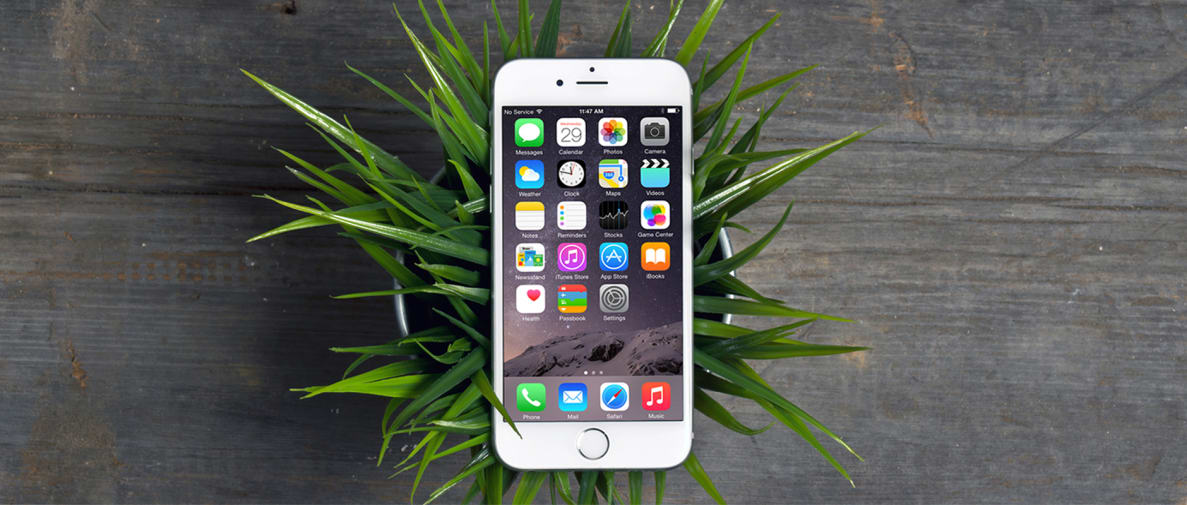Pros
Cons
In their heyday, companies like RIM (famed for their BlackBerry phones), NEXTEL, and Motorola rode the unbelievable success of their phones, but failed to innovate to stay ahead. Today, these companies serve as case studies in why you never settle with what you have; The Motorola Razr V3 was even more popular than the first few iPhones, for example, and yet Motorola fell victim to changing tastes and a more innovative competitor—Apple, itself.
With the new iPhone 6 (MSRP $649 unlocked, $199 on-contract) Apple seems to finally be learning that lesson. Though excellent hardware, a killer design, and a dead-simple operating system have lead Apple to the top of the mobile game, Android has made up ground with larger, high-resolution displays and relentless iteration.
These large-screen phones have proved so popular that Apple is now forced to get with the times, stretching the iPhone beyond its original 4-inch diagonal frame. Though the 4.7-inch iPhone 6 is still on the small side relative to most flagship phones (and the new 5.5-inch iPhone 6 Plus), it proves one very important point: Apple is finally willing to embrace change.
Design
Rounder, smoother, thinner, lighter
To say that the iPhone 6 is a massive departure from traditional iPhone design is a bit of an overstatement, but it's without a doubt the most drastic change to date. Taking a page out of Android's book, Apple finally bowed to pressure to provide users with the option of using a bigger display, as well as the usual improvements in performance, camera quality, and new additions such as NFC.
And though the iPhone 6's dimensions are quite different from the 5S, the aesthetics are distinctively Apple: rounded metal edges, the iconic home button, and many of the same design hallmarks of earlier iPhones. The buttons are—for the most part—in the same places they used to be, and even the layout of the front face of the phone is virtually identical to the iPhone 5S. Even the fingerprint scanner returns to Apple's latest flagship.
{{ photo_gallery "tour" }}
In some ways that's a great thing—the bottom-mounted headphone jack is great for durability, and the lightning port is just as awesome as it was when it was first introduced. However, questionable choices like the bottom-oriented speaker also make their return, and that's something we'd like to see given the boot. It can be extremely annoying to cup your hand over the side to hear what you're playing on your phone (the few times you don't use headphones, anyway), and the easy fix is speakers on the front face of the phone.
The phone is also impossibly thin, but it still brings a lot of muscle to bear. Apple's latest smartphone processor—the A8—runs under the hood backed up by 1 gigabyte of RAM. Compared to the 3GB found in many flagship Android phones that may not sound like a lot, but it's more than enough to handle day to day tasks in iOS with relative ease. The question remains how long this will be adequate, but if past iPhones are any indication, iOS 8 will carry this phone for much longer than you'd expect.
If we have one complaint about the iPhone 6 it's that it's a little too thin and light. Though the concerns about bending the phone's aluminum frame are far out of hand, it doesn't provide nearly as much purchase as the more rigid, squared-off iPhone 5S. It's more comfortable in the hand, sure, but it's so light and slick that it feels like it's liable to fly right out of your hand at any moment. As with most phones, a case will go a long way toward protecting it.
If you can get past that, the iPhone 6 is a joy to use. It slips easily in your pocket, and the 4.7-inch size is a wonderful compromise between too-large phablets and too-small 4-inch iPhones. Even if you primarily use your phone for browsing the web and playing games, there's more than enough screen real estate that you won't feel like you have to squint just to read your screen.
In Use
Fits like an old glove
Though Apple products have almost always been powerful, the company's biggest successes have generally married horsepower with a superb user experience. With the latest version of iOS 8, Apple has continued to sand down the rougher edges of last year's iOS 7, while offering users options such as NFC, mobile payments, and better customization. Mobile payments could prove to be the biggest of them all, and even though it's hit some significant snags, we'd put our money on Apple figuring this out sooner or later.
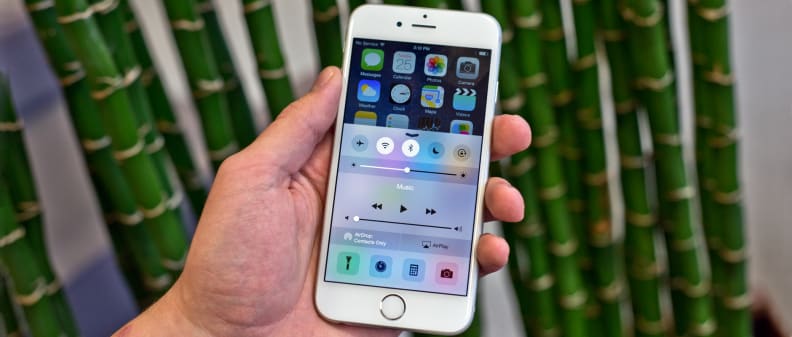
The quick settings panel gives you access to basic phone controls with only a swipe up on the screen.
But despite the notable additions, the best thing about iOS 8 is how familiar it'll feel to seasoned iPhone users; the aesthetics are the same, the control scheme is virtually identical, and the App Store is the same exact program bazaar that you're used to. And that's no accident—Apple wants its users to be able to upgrade to the latest platform without getting lost.
The result is an operating system that feels incredibly familiar, but is cleaner, more fluid, and more customizable than any version of iOS we've seen to date. It plays wonderfully across the larger display of the iPhone 6, and the improved customization options are an improvement. This is never more true than with the keyboard, which can finally be swapped out for more functional custom versions.
Ported Android keyboard solutions like Swype or Swiftkey make iOS 8 a joy to use, eliminating one of the most infuriating aspects of previous iPhones. These in particular let you drag your finger to type, which is a much faster method than simply doing the age-old hunt'n'peck. Apple has also borrowed the concept of widgets from Android—shrunken versions of third-party apps that can live in places like the home screen and notification tray—though the implementation isn't nearly as robust as on Android. Even if iOS will never be as user-tweakable as Android, these are along overdue concessions by Apple.
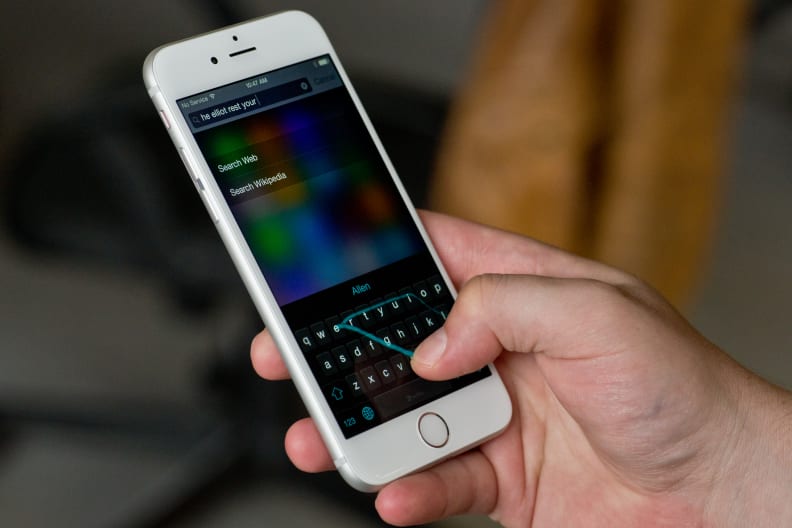
Swiftkey takes a while to learn your speech patterns, but it's super quick to type with.
It's interesting to see Apple start to dismantle the "walled garden" a little bit, and allow developers a little more leeway in changing basic system functions. As users and developers have become more advanced over the years, the incessant hand-holding of iOS has grown tiresome. Though that means that Apple more or less sidestepped the awkward adolescence that plagued early versions of Android, it also meant that it was more difficult to tailor your iPhone to fit your needs. The iPhone 6 and iOS 8 don't entirely fix this, but it's a step in the right direction.
Performance
Bigger and brighter don't always make for a better experience.
One benefit of such a tightly controlled operating system has meant that iPhones have long drubbed the competition when it came to performance. Though Apple has given the iPhone 6 a big leg up with an improved processor and larger battery, it has also given it a bigger, brighter screen to power. Drastic changes like this can lead to unintended consequences, and it looks like the iPhone 6 took a huge hit where it counts: battery life.
First, the good: The 4.7-inch (1334 x 750 pixel)display is a treat to look at. It's got a decent contrast ratio (1625:1) that's higher than most phones with an LCD, and the color performance is top-notch. Though the screen can feel a little low-res when you compare its specs with other phones on the market, its pixel density is still well beyond what's considered "retina"—the minimum pixel density needed for someone with 20/20 vision to be unable to discern individual points of light.
When outdoors, the iPhone's screen is always a fair contender, and the iPhone 6's (insanely high) peak brightness of 568.77 cd/m2 is far more than enough to dispel even the most pesky reflections. Though this brightness level will drain your battery quickly, using the auto brightness setting will keep your phone from dying in bright light—and prevent your retinas from melting when it's dark out.
Unfortunately, all that power comes at a cost: namely, power. Though casual users will get about a full day's use from a single charge, intensive tasks will rip down the 1,810mAh battery extremely quickly. In our web browsing rundown, it actually posted one of the worst scores we have collected to date. Setting the screen at 400 cd/m2 and letting the web script run with a full battery, it only took the iPhone 6 a measly 3 hours and 27 minutes to give out—almost half what we've seen with the best Android phones.
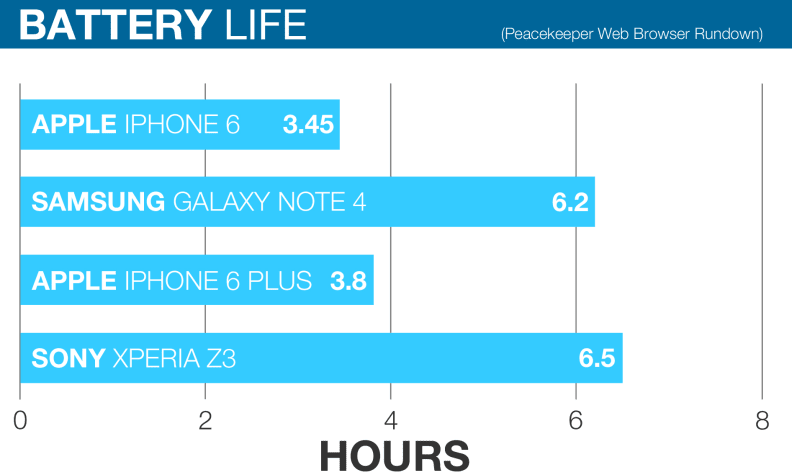
Neither iPhone does well when it comes to battery life, and the gap is widening.
It's this poor showing that holds the iPhone 6 back, giving us major concerns about how well it'll hold up in the long term. Your brand-new iPhone 6 may last a full day, but in a year you could be looking to top up before dinner. We expect Apple will find ways to optimize the phone to head off this problem, but if you're looking for longevity, something like the Sony Xperia Z3 is a far better option.
Camera
Low-res, but it's still one of the best around.
One area we're glad to see Apple continue to develop is the camera in the iPhone. Though on paper it seems like it might have the exact same 8 megapixel sensor as what you'd find in the 5s, it's quite a bit better in practice. Though optical image stabilization has been reserved for the larger iPhone 6 Plus, Apple threw in phase-detection autofocus on the iPhone 6, which greatly increases how fast your shots will come into focus.
Additionally, the camera is more capable when it comes to video. Though the iPhone 5S already saw the addition of slow-motion video with the update to iOS 8, the iPhone 6 can also shoot time-lapse video, as well as 1080p HD content at 60 frames per second. It may not sound like a huge improvement in the presence of 4K-shooting smartphone cameras, but it's more than enough for most people's purposes. The slow-mo footage, in particular, is just plain fun to use:
Taking this new camera module through our camera lab, we were pleasantly surprised that Apple seems to have paid particular attention to the software, as well. Accurate colors (∆C00 saturation error of 2.4), mild oversaturation (118%), and low noise levels are hallmarks of the iPhone camera—and the new one holds true to the performance of its predecessors. Shots are acceptable even in low light, as Apple's noise reduction algorithm does a fine job of keeping noise low while retaining most detail. You won't want to print shots from a dim bar or restaurant, but that may have nothing to do with the image quality.

The iPhone 6's camera is improved in low light, but as you can see here sharpness is limited when viewing shots at 100%.
Images are slightly softer than the competition, but still within acceptable limits. We measured an average resolution of 1,485 line widths per pair height (LW/PH) at MTF50. Basically anything around 1,500 or higher is acceptable, so the iPhone does fine here. One thing to note is that the iPhone doesn't make use of extreme software-based oversharpening here; the camera only enhances edges by roughly 2.89%, where phones like the Samsung Galaxy S5 do so by about 20%.
We saw some sharpness struggles in video motion, despite the camera having no trouble with frequency interference or trailing. Resolving 700 line pairs per pair height, this is one of the sharper cameras in a phone—excepting the ones that can shoot 4K video, that is.

Dark scenes are tough for any camera, but it gets worse when there's a lot of lights around you.
Of course, the main benefit is that—like all other iPhones—you've got access to the entire App Store's library of camera apps. These will let you tweak photos to your heart's content, shoot with full manual settings, and even capture RAW shots. Though mobile phones still aren't on par with high-end point-and-shoots in terms of image quality, the creative options are limitless.
{{ photo_gallery name="Sample Photo" }}
Conclusion
Apple is thinking different, once again.
So should you buy an iPhone 6? That's easy: if you loved an iPhone in the past, you'll love the iPhone 6. It's everything that we've loved about previous iPhones but with a bigger screen, improved user interface, better camera, and faster processor. It has worse battery life than the iPhone 5S, but if you are like us and spend most of your time on your phone using the web, messaging, or consuming content the larger screen is a must.
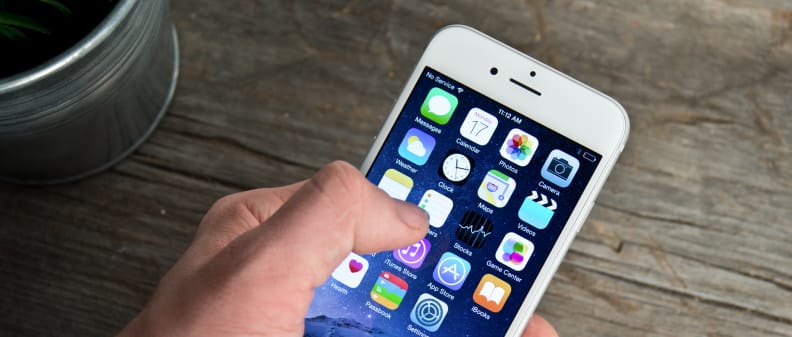
The iPhone 6 is the Goldilocks phone size—big, but not too big.
Even if you don't want a giant phone, the 4.7-inch display on the iPhone 6 is the perfect sweet spot. It'll feel big compared to the older 4-inch iPhones, but once you adapt you'll never want to go back. And because Apple elected to keep the size under five inches, it's just as easy to use with a single hand. It's also lighter, smoother, thinner, and has an improved operating system—though we're still partial to the more squared designs of the 5S.
Compared to the 5S, the biggest tradeoff you're making is accepting poorer battery life in exchange for a larger screen. The battery life here is acceptable, but we have long-term concerns about how it'll do once you've put it through its paces a few hundred times. There's certainly lots of room for improvement, and power users will find a USB backup absolutely essential.
All in all, the iPhone 6 is a very credible upgrade to the iPhone 5S. It's not perfect, but it's a worthy flagship from Apple that goes toe-to-toe with Android, smartly borrowing some of the best features from Google's operating system without losing what has made the previous iPhones so popular. It's a signal that Apple is finally challenging some of the design principles that got Apple to this point, but were keeping iPhones from growing further (literally).
If you need an even larger companion, the iPhone 6 Plus offers a very similar performance to the iPhone 6—but with a gargantuan 5.5-inch display. It has similar battery life issues, however, and if that scares you off we recommend looking at something like the Sony Xperia Z3 or Samsung Galaxy Note 4. However, if all you want is the same iPhone experience—just bigger and better—Apple finally has you covered.
Meet the tester
A seasoned writer and professional photographer, Chris reviews cameras, headphones, smartphones, laptops, and lenses. Educated in Political Science and Linguistics, Chris can often be found building a robot army, snowboarding, or getting ink.
Checking our work.
Our team is here to help you buy the best stuff and love what you own. Our writers, editors, and experts obsess over the products we cover to make sure you're confident and satisfied. Have a different opinion about something we recommend? Email us and we'll compare notes.
Shoot us an email

